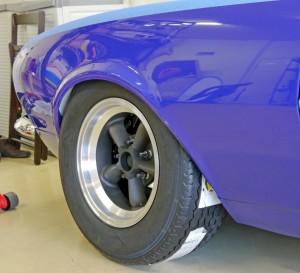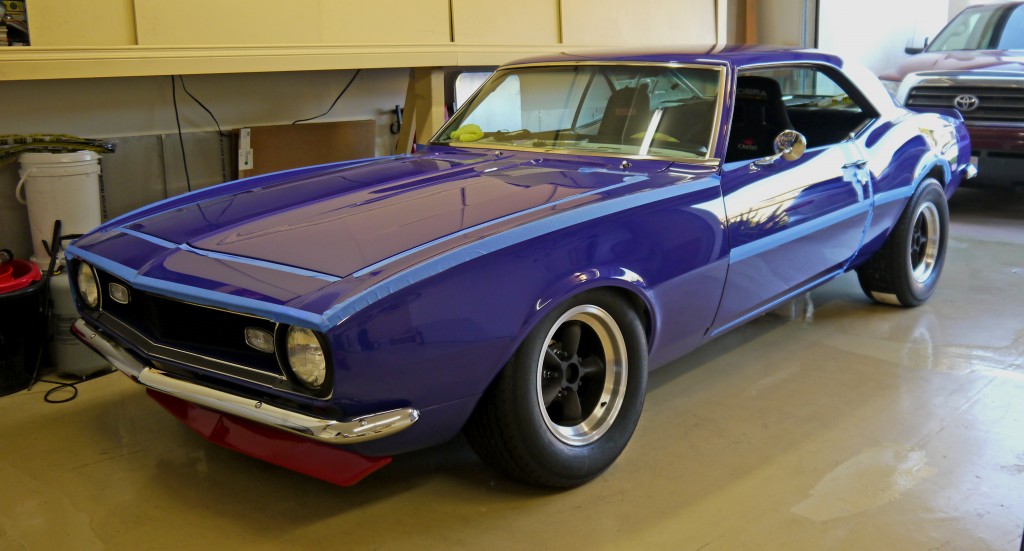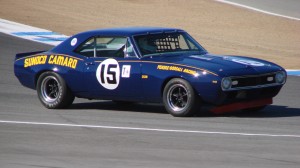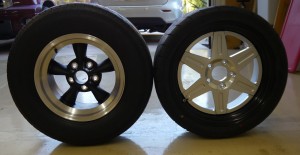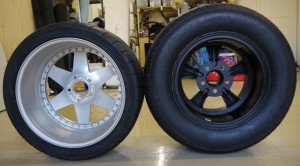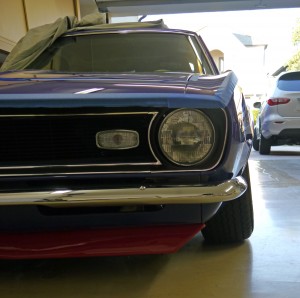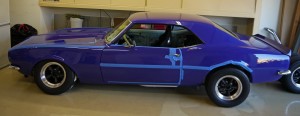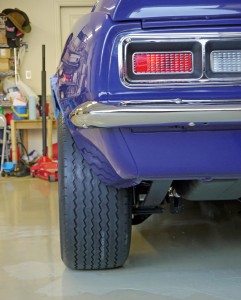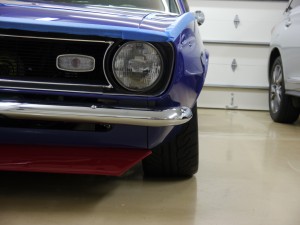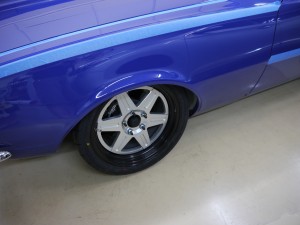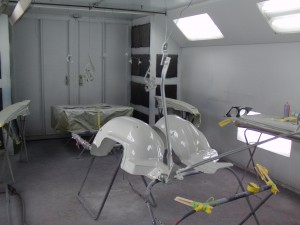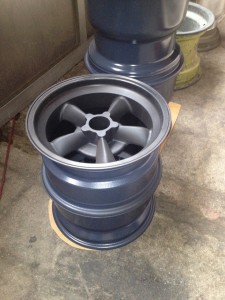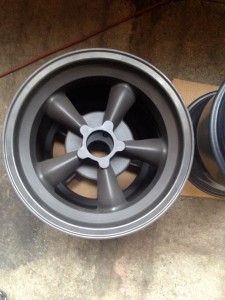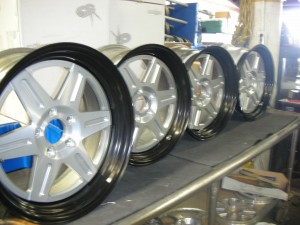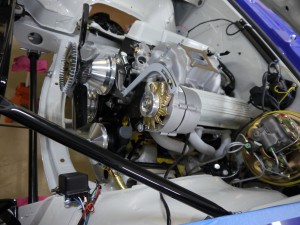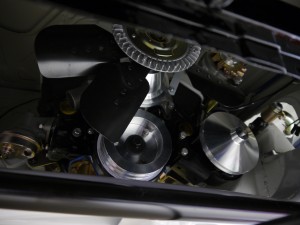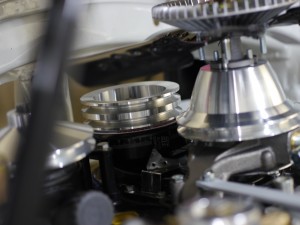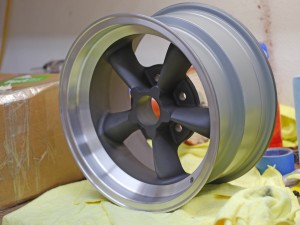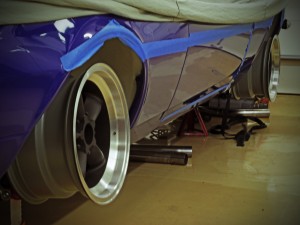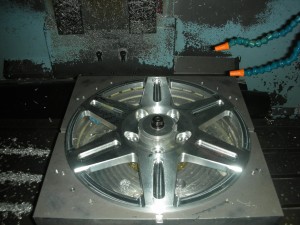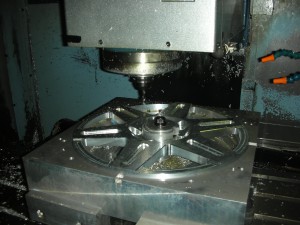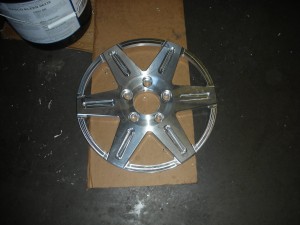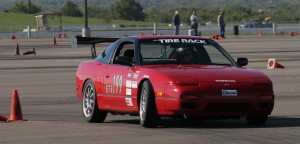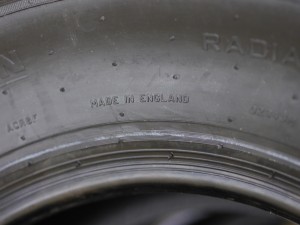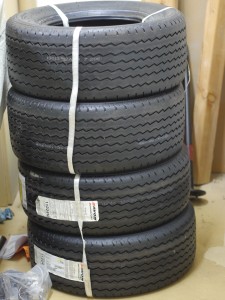Beautiful wheels, horrible ride heights
Yesterday the other two Vintage Engineering magnesium wheels showed up. There are the best replicas of the wheels used in the Trans-Am racing series you will find anywhere. I went with the American Racing Torq-Thrust 5-spoke design, though the Minilite design everyone had switched to by 1969, is also available.
Nobody really makes magnesium wheels any more, and there are a lot of interesting tidbits to know in the “care and feeding” of mags. Since they are cast, they have some fragility – you don’t want to use more than 25-30psi when seating the beads, as the explosive force of the tire seating, can actually damage the inner flange on the wheels, which is not generally repairable. Fortunately the Avons beaded up with under 20psi – these are no 30-series R compounds!
Second, you don’t want to use normal tire-mounting lubricants, because water and soap is bad for magnesium – especially so anything left inside the tire, as it will just sit and eat away at the metal over time. The barrels of these are painted, but it only provides so much protection. The tires were mounted today using a bunch of WD-40 as the lube.
Quick shout-out to the folks at the Discount Tire at Balboa & Genesee in San Diego. I have been going to those guys for years, and when other shops in town turned away me and my big and difficult-looking SM240 or Viper wheels and tires, the crew at this Discount always helped me out, getting things done quickly and without incident. If you’re in town I highly recommend them!
Third thing is that like Gremlins, you don’t want to let them get wet. Of course some moisture is inevitable, but if left on an unprotected surface, it causes magnesium to oxidize and eventually pit. Magnesium parts last a lot longer in dry climates – fortunately San Diego is arid/desert climate, and I’m far enough inland the ocean salt air is not a problem. The spokes and inner barrels of these wheels are protected with a “DOW 9” galvanic anozide – fancy chemical tech from WW2 which holds up and protects the magnesium better than paint can. Only the outer lips are left unprotected, which polish up beautifully, and can be protected with a corrosion-inhibiting oil like WD-40, though for these wheels I was recommended Gibbs by Ray Franklin at Vintage Engineering.
I really like these wheels. In looking at a million pictures of Camaros, it took me about 999,000 images before I realized why I prefer the looks of the classic Trans-Am cars over any of the megabuck modern Pro-Touring cars – it’s the tall sidewall on the modest-diameter wheel that does it. There are some nice modern designs out there in strong and light wheels from companies like Forgeline and CCW (remember I was originally considering CCW way back when) that are extremely popular with the restomod crowd – but unfortunately none of their designs really fit the vintage look. There are even a ton of manufacturers replicating the Torq-Thrust wheel design, but for one reason or another – spoke shape, colors, maybe even the grain texture in the aluminum used – nothing seemed to fit.
These Vintage Engineering wheels look exactly like what’s on the original vintage Trans-Am cars you’d see at the Monterey Historics – partially because a lot of those racers run these wheels too… 🙂
Since 18″ is today’s hot wheel diameter and all the good modern ST tires for the Camaro come in 18″ sizes, decided to attempt emulating the short-wheel, tall-sidewall look with the Jongbloed 214 wheels I had built for STX:
If you’re comparing these two wheels/tires from a distance, they don’t look much different. The one on the left has a silver lip with black center, the one on the right is silver from center to the lip…or is it?
A view from the back of the wheel tells the real story-
how state-of-the-art wheel & tire technology has changed a lot in 45 years. The Jongbloed here with a 265/35-18 Neova, has a sidewall that’s only about 3.5″ tall. The Vintage Engineering wheel with its 275/55-15 Avon CR6ZZ, has a sidewall that’s almost 6″ tall. This is just how modern when and tire design are going – larger and larger diameter wheels, with shorter and shorter tire sidewalls. There are benefits to this – more responsive tires, room for bigger brakes among them – but a lot of it seems to be to help make today’s huge cars appear smaller. Heck – the Infiniti JX35 you see peeking out in the photo below, comes with 20″ wheels from the factory!
On the offset/backspace/sunken battleship front, the Vintage wheels are not nearly as bad off. The fronts are only 4.25″ backspace, and as you can see in the first picture, they have no room to go further outboard, even if the car was raised an inch or two. From the front it still looks a little weird but not too bad I suppose:
With their shorter height, I should be able to get the STX Jongbloed wheels out at least this far. Sort of a bummer the Camaro’s inner wheelhouse is all metal – there’s another inch to go outboard per side without changing the fender’s exterior contours one bit, but doing so would require re-shaping the inner wheelwell structure, which isn’t permitted due to it being metal. Another two inches of front track width would be of tremendous benefit to front grip. One could conceivably raise the car up enough to allow for the track width increase, but that would be something like a 10% increase in (worsening of) CG height, in exchange for about a 3% increase (betterment of) track width. Not a worthwhile tradeoff.
Speaking of raising and lowering, ride heights are all wrong, this picture illustrates it best:
As mentioned in a recent post, the rear ride height is too high by about 3″, waiting on some new composite leafs to bring it down to earth. Front is too low, especially for these tires. They are 26.7″ tall front and rear, making the fronts about 1.5″ taller than the STX race wheels and tires.
Believe it or not, this looks a lot less bad than the car did on its 18″ Neovas. Partly because of the equal tire height here front to rear – the Neovas are 1″ shorter in the front than the rear, exacerbating the dragster-ish ride height weirdness. Next time the car’s in the air I’ll probably raise the front an inch or so, just to be conservative. Actually a little concerned I may not be able to make it through the gutter at the end of my driveway and onto the street, without damage.
Will be nice to get the rear lowered – at the moment it’s not doing a very good job of hiding its horse-and-buggy underpinnings!
You sunk my battleship
In part 4 of Comparative Vehicle Dynamics we went through looking at the key variables contributing to lateral grip and skidpad performance. Both these things are very important in autocross, where you spend the vast majority of time at the car’s lateral limit.
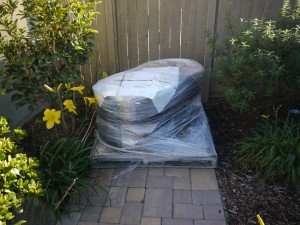 (Wheels and tires arrived on their own pallet, very nice!)
(Wheels and tires arrived on their own pallet, very nice!)
One of those key variables is track width – the wider, the less lateral weight transfer, and the more potential grip at the axle. This width ends up costing later in transitions, but my preference is still to take the wider track width, especially on a car that is somewhat under-tired compared to its competition. Especially too in the front, where the width tends to be a bit more manageable through slaloms. Especially three, in a car that has craptastic front suspension geometry, no ABS, etc.
When measuring for front wheels, most of the look-see was done at ride height, with the camber values around -1. I knew I’d run more negative for racing, but on the weird chance I ran more straight-up for the street or whatnot, wanted to be sure the wheel/tire wouldn’t be out of room outboard; a wheel too far inset can be pushed outward easily with spacers – ones too far outboard, require the use of those hard-to-find “negative displacement spacers” 😉
It looked like 5″ backspace might just barely be not enough backspace in front, and since it was easiest to step in .5″ increments, went with 5.5″ front backspacing. This was a bit of a bummer, since 5″ looked perfect (and after delivery still appears perfect) for the rear, meaning the front and rear wheels would (and do) have different dimensions.
When putting the car back on the ground for the first time in forever, I had the front suspension at its full -6 degrees camber. While the exact amount varies based on tire diameter and where you are already aligned, in general, for every one degree of negative camber you add, you move the top of the tire inboard by about .1″. So by adding over 4 degrees more negative camber from where I was when first measuring for wheels/tires, I moved the top of the tire inboard by over .4″, almost half an inch.
In the 240sx world when I owned mine, some people worked to get their wheel/tire combination pushed every last bit out to the limits inside their fenderwells. Tires so close to metal, you’d swear there’s no way they’d clear as the suspension moved, yet somehow they did. This was the pursuit of “flush stance” and those that achieved it were “hellaflush”. While this pursuit is mostly for looks, I happen to generally agree with the idea, as the further outboard you go, the more you’ve widened the track width. When done right, I think it looks good.
For every trend that gets branded, the opposite of the trend has to get branded too, and those that ran wheels/tires with too high an offset, or too much backspace, were said to have “sunken battleship” – because the wheel/tire appeared sunken into the wheelwell when viewed from the side. That’s how the Camaro looks with this backspacing – ugly and certainly not hellaflush!
I have some wheel spacers to go buy now for sure. Won’t be able to get the wheel/tire all the way out to the outer edge as is the modern style, with this car under the ST ruleset. The wheelwell is made of metal, and there is no allowance for its modification. Just inside of the outer blue fender, the inner fender has a flat plane for 1″ or so, before it forms a bowl shape upward. You can see it somewhat here, the wheelwell on the right has its outer portion facing the camera (inner portion is not a problem):
Because of this, the front of the car would either have to be up really high (blech!) or have a bit of the sunken battleship. I believe the wheels can go outboard at least 1/2″ from the above, possibly up to 1″ per side. Based on some Photoshop pixel math, it looks like the wheels need to go outboard 1″ to have the outer portion of the tire at the ground in line vertically with the exterior fender lip.
In addition to the extra track width on the end that needs it, this has the additional benefit of allowing for a bit more steering lock before the tires start to rub the frame inboard. But most importantly it should look much much better!!!
Would have a profile shot of the whole car on the ground at this point, but it looks ridiculous, as the rear springs are about 3″ too high. Like a wonky dragster, but worse. New rear springs are on order but will take while…ugg…
Few random pictures – two sets of wheels & engine compartment
Some of the prettier aspects of the car should be coming together soon. These first two are of the Vintage Engineering magnesium wheels, after coming back from receiving their DOW 9 coating.
Ray at Vintage then drills for the Camaro bolt pattern, and removes the coating from the outer lips with a scotch-brite pad on a lathe. When done they look like the other two I’ve already received. When they’re all here, will get the vintage-style Avons mounted up and put on the car.
Those are just for the street and any show-type activities though. The ones below are the real deal race wheels. 18×9″ Jongbloed 214 Aero, with custom backspacing, different front and rear.
Jongbloed mounted up my first set of brand new shaved ST tires on those today, should have them this week. Congrats to Mike Heinitz for correctly identifying the wheel pattern after I showed them in process back here.
Below are a few of the engine compartment, coming together, for real this time! 🙂 The March Performance pulleys look really great – they add a pop of shine without the obnoxiousness of chrome, and don’t betray the simple mostly-stock, all-business look I’m after.
With any luck I’ll have some rollers on this thing for some out-in-the-driveway shots this weekend.
First two “road & track” wheels arrived
Should go from having no wheels & tires, to two sets, in another week or two. Pleased to see these Vintage Engineering 15×8 wheels fit my aftermarket big brake setup front and rear.
These are the ones I’ll use up front, with 4.25″ backspace. With a 15″ wheel, that’s all you can go (maybe 4 3/8″ max) before you have interference with the outer steering boot. Rears will have a bit more backspace (4.75″) to help fit the big 275 rear tire.
The plan for these wheels is to use them on street and on the track, and for any show-type events. I’m not really a car show type of person, but with the right stickers, hoping it could pass as a Penske/Sunoco replica to the untrained eye.
Once the rear wheels arrive, will get the Avons mounted, and see how this thing looks on the ground! There’s a good chance my STX wheels and tires will be arriving at the same time, should make for a lot of fun photos!
Wheels getting made
Finally some progress on my wheel manufacture, got a couple pics to share of the centers being made:
Can anyone guess the make and model?
The car’s first set of tires
If you’ve followed along in my Comparative Vehicle Dynamics series, and you didn’t already know, you’ll no doubt come to the conclusion, that tires are an extremely important, if not the most important, part of a race car.
My 2006 run in the STS class was fueled largely in part by the availability of (for the time) next-generation tires for my 17″ wheel, 25″ diameter tire’d 240sx, vs. their 15″ wheel, 23″ diameter Civics. I’d had the chance to experience one of these tires (Yokohama Advan Neova AD07) the year before on an IS300, and knew they held a real edge over the Falken RT-215 still popular on STS Civics. I found I was even faster on the Bridgestone Potenza RE-01R released in 2006, even if I didn’t like the feel of the tire as much, as the Yokohama.
The point of all this, was the 240sx was a fun, but rather expensive experiment, where the hypothesis went something like “A car that has no business doing well, can not only be competitive, but possibly win in Solo, due to a small tire advantage”. I think this hypothesis was proved correct even if it wasn’t the fastest both days – besides, the 240Ssx ran away with the ProSolo win, as it was able to take advantage of its other strengths – namely RWD and torque.
So, tires matter a lot, and if there’s one place you can give yourself a meaningful advantage, it’s there. Chasing every last HP and ounce of weight are also useful pursuits, but in almost any case, I’d give those up to get a tire edge.
But unfortunately, there are only so many tires out there. The leading edge street tires are focused enough in their development, the odds of finding a ringer, that through some weird trick, happens to outperform 2012’s usual suspects (Toyo R1R, Yok AD08, Bridgestone RE-11, Dunlop Star Spec, Hankook RS3, Kumho XS, and now the Michelin PSS) is pretty much nonexistent. Plus the STAC wisely toughened the entry requirements for ST tires, mandating they be available in the same diameter/size counts as Stock-legal tires, which eliminated possible ringers like the Nissan GTR and Ford GT500 OEM tires.
As of this writing I don’t really have a good sense for where I’ll be going with the race tires for this car. Looks like there’s more coming out in the off season, so 2013 stands to be a lot different than the past couple years, in the tire makeup in grid.
It does look like I’ll need to run 18″ wheels though. I for sure want to run the class-max width size (265) and most manufacturers only offer that width in 18″ diameter. While this size defies the vintage look of the car, it does allow for a lot of additional backspacing in the front, making it easier to fit the tires. With 15″ wheels, I appear to only have about 4.25″ of backspace room, before the wheel would hit the steering arm. With 18″ wheels, I’m aiming for more like 5.25″ of backspace.
I do have some 18″ wheels on the way. They’ve been a work in progress the last several weeks, at a small race wheel shop here in California. If I’d gone with CCW I’d probably have received my wheels weeks ago, as Purner is so solid on turn-around times, but even though I’m going 18″ for race wheels, I wanted to go with a style that at least tried to look vintage. Purner’s stuff, even the “classic”, all felt a bit too modern for the car. Hopefully the style I’ve picked for this first set looks good, the wheel maker is so low volume, there are very few of his wheels out in the wild.
In all this research of tire and wheel makers, and looking at the universe of first-gen Camaros out there, I decided I pretty much hate every large diameter (>16″) wheel that’s been put on these cars. Some look less awful than others, but the styles are all so modern, they just seem to contradict the rest of the car. And it’s not just the wheels, the tire sidewall is a big part of it too. A modern 265/35-18 tire is about 25.5″ tall, with a sidewall height of only 3.6″. A vintage 7.00-15 Goodyear Blue Streak, is 26.7″ in diameter, with a sidewall almost 6″ tall.
If I’m working to make the car competitive in SCCA autocross, I’m going to run the best tire for the car I can, which means running the correct diameter wheels, which means probably not running on the car in autocross, what I think looks best, or suits the car best. Lots of work has gone into making the car look the way I want, and I was careful to allow backwards-compatibility with vintage-sized 15″ wheels. My interest in pursuing a vintage set of wheels and tires was piqued recently, when I came across a thread discussing vintage racing tires for Cobras.
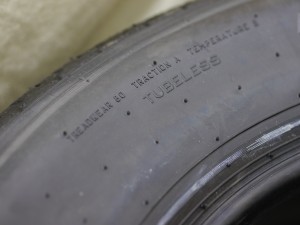
In it, many people spoke highly of a certain model Avon tire – the CR6ZZ. Available in tall sidewall sizes, but built with modern techniques and knowledge. Great on the track once warmed up, great in the wet, and fun on the street, with many people getting over 10,000 street miles in their hot rods. Only downside is cost – one set of 245/60-15 (front) and 275/55-15’s (rear) cost more than the last set of 335/30-18 and 345/30-19 Hoosier A6’s I bought for the Viper.
I figure these will last a lot longer than those A6’s – the Camaro isn’t likely to get many street miles, so these things are likely to die of old age before being worn out. Of course they supposedly they make great track tires, so they may see some use in that capacity as well. Ironically, since they are Treadwear 80 tires, I won’t be able to run them STX, even if I hadn’t gone with the wide 275 rear tire.
The wheels for these tires are a very special set, made by an even smaller wheel company than the one doing my 18″ wheels. This latter company, makes a lot of the wheels used by real vintage racers, the guys running the original Trans-Am and Can-Am cars at events like the Monterey Historics. Even when narrowing my search of wheels to original style and size 15″ Minilites and Torq-Thrust wheels, nothing available new today from the regular makers seemed to look right, except these guys. They just so happened to have four in their inventory, normally I’d have to wait 6-8 months to get a set, but instead I should have them soon.
Hope to get the car on the ground soon, on this vintage style wheel/tire setup. I’ve had the car sitting with jackstands under the suspension to try to get things to settle a bit, but the rear is still about 3″ too high, and there’s not much weight left to put in that’ll drop it, save for fuel.
